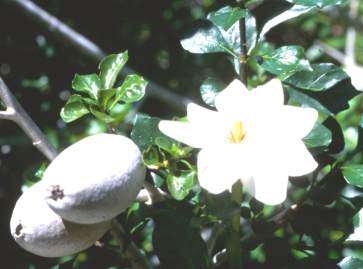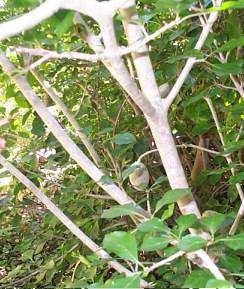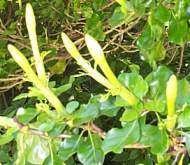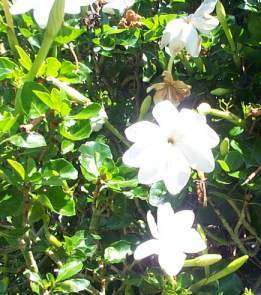
Spring Sale - Gardenia thunbergia - Wild gardenia (50 Seeds)
Check my rate
| Main centres: | 1-3 business days |
| Regional areas: | 3-4 business days |
| Remote areas: | 3-5 business days |

| Main centres: | 1-3 business days |
| Regional areas: | 3-4 business days |
| Remote areas: | 3-5 business days |
LOURENS TRADING CC
ITEM: Gardenia thunbergia
COMMON NAME: Wild gardenia / Witkatjiepiering
FAMILY: Rubiaceae
SIZE: Up to 3m

Gardenia thunbergia is a beautiful flowering shrub or small tree, with showy, heavily perfumed flowers and decorative fruits.
Description
This is an evergreen shrub or small tree, 2 to 5 m in height, with a smooth, whitish, usually straight main stem up to 250 to 300 mm in diameter, and short, rigid branchlets. The leaves are
carried in whorls of 3 or 4 crowded near the ends of the branchlets. They are a glossy light green, hairless, softly to thinly leathery and conspicuously veined. Simple with an entire, wavy
margin, variable in size, up to 140 x 60 mm but usually smaller, mostly oval, tapering abruptly to a rounded or blunt tip while the base tapers onto the stalk.
The flowers are large, showy, creamy white and heavily perfumed, particularly at night. They open from elegantly furled creamy-green buds. The flowers do not turn yellow as they age on the bush.
The corolla is a 70-120 mm tube with 8 large lobes spreading to ¿ 80 mm in diameter. Flowers are produced abundantly during summer (October to March), peaking in late
summer (January to March). The fruits are hard and woody, and heavily fibrous inside, and where not being browsed by large antelope, can remain on the bush for years. Each fruit is
egg-shaped, greyish green, 50-75 x 35 mm, when mature roughly dotted with whitish encrustations.
Ecology
Moths are attracted to the flowers and are probably the pollinators. The fruits do not burst or split open, or drop, and can remain on the bush for years. They are adapted to being eaten
by elephants, large antelope and buffalo, and the seed coats are tough enough to pass through their digestive systems unscathed. Unless man intervenes, the seeds will not be released
from the fruits and dispersed unless these animals eat them. Harvesting Gardenia thunbergia seed is hard work. The secateurs we use to cut off the fruits are blunted by the end of the
process, not to mention our hands that are also worn out. We have to use hammers, or any heavy, blunt instrument we can find to break the fruits open, and nails and heavy duty spoons to
scoop the seeds out. It is heavy, laborious, unpopular work! Distribution Gardenia thunbergia occurs in a strip up the eastern coast of South Africa from near Grahamstown in
Eastern Cape to Kosi Bay in the north of KwaZulu-Natal. It occurs primarily in evergreen forest and forest margin, occasionally in woodland and bushveld.
Derivation of the name & historical aspects
The genus Gardenia was named in honour of Dr Alexander Garden (1730-1971) a Scottish physician who practised in South Carolina, USA, and a correspondent of Linnaeus.
This species was named after Carl Thunberg, pupil of Linnaeus and a well-known 18th century botanist and traveller in South Africa. The Afrikaans common name buffelsbal means buffalo
testicles, a reference to the shape of the fruit. The Zulu name umvalasangweni means the back-gate closer and refers to the fact that it and other spiny shrubs and trees are used as the
gates for cattle kraals Gardenia thunbergia was the first of the South African gardenias to be known to botanists, and was introduced to Kew in 1773. The gardenia family (Rubiaceae) is
a large, cosmopolitan family containing 630 genera and 10 200 species.
This family's greatest claim to fame is the South American quinine tree, Cinchona, whose bark yields quinine, the first drug ever used to treat malaria. Coffee, Coffea arabica, is
also a member of this family. In South Africa, the family is best known for its decorative flowering trees and shrubs: Gardenia, Rothmannia, Hyperacanthus, Alberta and Burchellia.
The genus Gardenia consists of approximately 60 species that occur in tropical and warm parts of the Old World. Six species are found in South Africa, in all provinces except the
Northern and Western Cape. Gardenia thunbergia can be readily distinguished from other similar species growing in South Africa, but is possibly often confused with other species growing
in Zimbabwe and further north. It may be distinguished from G. resiniflua, the gummy gardenia, by its much larger fruits, and from G. volkensii, the Transvaal or savannah gardenia, by the
fact that its fruits are not ribbed. G. cornuta, the Natal gardenia, which has un-ribbed fruits of similar size and shape can be distinguished by the fact that its fruits are orange not grey.
G. ternifolia (= G. jovis-tonantis) the large-leaved Transvaal gardenia, has short hairs on both leaf surfaces, which are rough to the touch, whereas G. thunbergia leaves are smooth and hairless.
Another distinguishing feature is that G. thunbergia flowers do not age yellow as many of the other species do. Hyperacanthus amoenus (= Gardenia amoena) the spiny gardenia, has
paired spines at right angles to the next pair, and pink tinged white flowers. Gardenias are also quite similar to rothmannias, but an easy way to distinguish them is by their flowers:
gardenia flowers are tubular with many petals, whereas rothmannia flowers are funnel shaped with only five petals.
Uses
Roots are widely used in Africa to treat skin diseases, and skin lesions caused by leprosy. The roots are also used as an emetic against fever. The rootbark is used as an emetic for
biliousness, and to treat gall bladder problems. The roots and leaves are used in various parts of Africa to treat syphilis, and the latex is used as a purgative. The wood is heavy, dense
and extraordinarily hard, a pleasing yellowish colour, and it presents a high lustre when polished. It also has the unusual ability to bend without breaking, but its use is limited because
it is difficult to find large pieces. It is used for making buttons, tools, clubs, yokes, axles and implement handles. The fruits would make novel Xmas baubles



